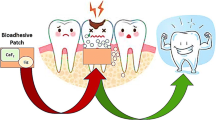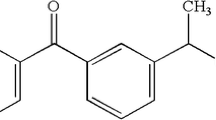Abstract
The application of drug delivery systems in oral environment is relatively a new area of research with the exception of release of fluoride ions from polyalkenoate cements and their predecessor silicate cements. The present study addresses development of a novel device based on ethylene vinyl acetate copolymer (EVA), a biocompatible material which enables constant drug release over several days to treat oral infections. Drugs incorporated in EVA included tetracycline, minocycline and nystatin together with combinations (C) of nytatin-tetracycline (1 : 1) and nystatin-minocycline (1 : 1). Polymer casting solutions were prepared by dissolving EVA and the drugs in the ratio of 10 : 1 in 70 ml of dichloromethane at 38 °C for 6 h. Thin square films of 3×3 cm and 1 mm thickness were cut from the dry sheet obtained by solvent evaporation. Drug loaded samples were extracted for a minimum of 15 days in 10 ml medium (water or water/ethanol (1 : 2) or 0.9% saline solution) which is replaced daily. Spectral measurements were made to follow changes in optical densities (OD) during release kinetics. Analysis of the data revealed that among all the drugs tested tetracycline exhibited the highest release rate (56.15ug/cm2/day) and % cumulative release (27.92).The observed enhanced values may be interpreted as due to the channels formed due to changes in free volume (microvoids). In case of nystatin-minocycline combination, the observed increased values of release rates and percent cumulative release, may be attributed to the swelling component or channels or relative hydrophobic interactions. Initial “burst” effects due to liberation of surface-bound drug molecules were observed with reference to all the three drugs and the combinations of drugs studied. Among all the drugs, minocycline exhibited the least “burst” effect suggesting that the drug is more homogeneously distributed in the copolymer. Drug loaded EVA thermoplastic copolymer may provide a favorable therapeutic material for the development of a novel, local treatment for oral, mucosal and periodontal infections.
Similar content being viewed by others
References
P. D. Riggs, M. Braden and M. Patel, Biomaterials 21 (2000) 345.
M. Braden, R. L. Clarke, J. Nicholson and S. Parker Berlin (Heidelberg, Springer, 1997) 1.
J. S. Lee and K. N. Kim, J. Dent Res. 74 (Special Issue) (1995) Abstract No. 56.
M. P. Patel, G. J. Pearson, M. Braden and M. A. Mirza, Biomaterials 19 (1998) 1911.
B. K. Drummond and J. C. Rodda, in “The Intraoral Delivery of Fluoride in Oral Mucosal Drug Delivery”, edited by M. J. Rathone (Marcel Dekker, Inc, New York, NY, 1996) pp. 381-405.
M. Addy and R. Handley, J. Oral Rehabil. 8 (1981) 155.
S. J. Wilson and H. J. Wilson, ibid. 20 (1993) 311.
P. Germo, P. Bonesvoll and G. Rolla, Arch. Oral. Biol. 19 (1974) 1031.
J. W. Rapley, C. M. Cobb, W. J. Killoy and D. R. Williams, J. Periodont. 63 (1992) 817.
M. J. Doyle, W. Buchanan, G. R. Kelm, M. P. Meredith, S. L. Welson, T. J. Charles, K. R. Wehmeyer, J. G. Collins and S. Offenbacher, J. Dent. Res. 73 (1994) 117.
M. P. Patel, M. Braden and S. Downes, J. Mater. Sci. Mater. Med. 5 (1994) 793.
J. D. Smilack, Mayo. Clin. Proc. 74 (1999) 727.
I. Magnusson, Compend. Contin. Educ. Dent, 19 (1998) 953.
B. V. Somayaji, U. Jariwala, P. Jayachandran, K. Vidyalakshmi and R. V. Dudhani. J. Periodontol. 69 (1998) 409.
G. P. Bodey, in “Candidiasis, Pathogenesis, Diagnosis and Treatment”, second edition, edited by G. P. Bodey (Raven Press, Ltd., New York, 1993) p. 371.
R. Langer and J. Folkman, Nature 263 (1976) 797.
S. Kalachandra, S. Offenbacher and R. Williams, in “Current Research Trends in Polymer Science”, 5 (2000) 1-17.
S. Kalachandra, Lin Dongming and S. Offenbacher, AADR abstract, Chicago meeting (March, 2001), in press.
Sufang Geng, Lin Dongming and S. Kalachandra, AADR abstract, Chicago meeting (March, 2001), in press.
US Patent 4069307 (1978).
T. G. Park, S. Cohen and R. Langer. Macromolecules 25 (1992) 116.
H. K. Sah, R. Toddywala and Y. W. Chen. J. Controlled Release 20 (1994) 201.
H. T. Wang, E. Schmidt, D. R. Flanagan and R. J. Linhandt. ibid. 17 (1991) 23.
J. M. Bezemer, R. Radersma, D. W. Grijpma, D. J. Dijkstra, J. Feijen and C. A. Van Blitterswijk. ibid. 64 (2000) 179.
Author information
Authors and Affiliations
Rights and permissions
About this article
Cite this article
Kalachandra, S., Dongming, L. & Offenbacher, S. Controlled drug release for oral condition by a novel device based on ethylene vinyl acetate (EVA) copolymer. Journal of Materials Science: Materials in Medicine 13, 53–58 (2002). https://doi.org/10.1023/A:1013634518797
Issue Date:
DOI: https://doi.org/10.1023/A:1013634518797




